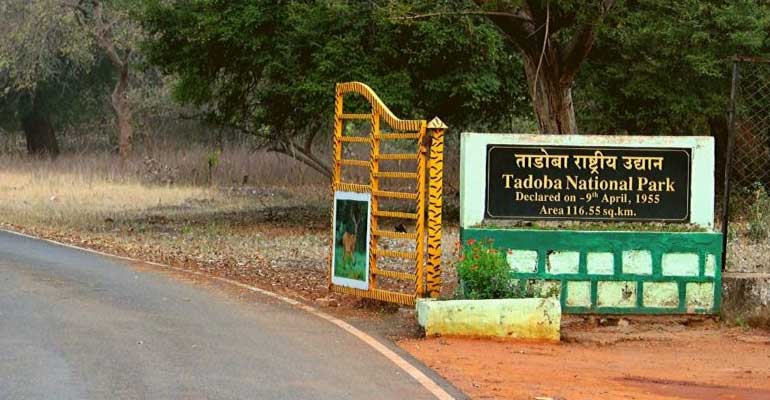
Tadoba National Park, also known as Tadoba Andhari Tiger Reserve, is located in the Chandrapur district of Maharashtra, India. It is one of the oldest and largest national parks in the state and is renowned for its rich biodiversity, particularly for being a tiger reserve. The history of Tadoba National Park is fascinating and spans several decades. Here is a detailed account of its history:

Early History of Tadoba Andhari : The region encompassing Tadoba was originally inhabited by various indigenous tribal communities, such as the Gond and Kolam tribes. These tribes lived in harmony with the abundant wildlife and dense forests of the area.
Colonial Era of Tadoba : During British colonial rule in India, the forests of Tadoba were heavily exploited for timber and other resources. The region was declared a reserved forest in 1935 under the British Raj to protect the forests and the wildlife within.
Evolution into a Wildlife Sanctuary : In 1955, the Tadoba National Park area was declared a wildlife sanctuary, primarily to safeguard the endangered species present there, including the Royal Bengal Tigers. It was initially known as the Tadoba Sanctuary.
Expansion and Renaming : In 1965, the Andhari Wildlife Sanctuary, adjacent to the Tadoba Sanctuary, was created. The two sanctuaries were combined in 1995 to form the Tadoba Andhari Tiger Reserve, and the area was officially designated as a national park.
Tiger Conservation Efforts : Since its inception as a tiger reserve, Tadoba National Park has been actively involved in the conservation and preservation of the Royal Bengal Tigers. Conservation measures, such as anti-poaching efforts, habitat management, and community involvement, have been implemented to protect the tigers and their habitat.
Tourism Development : Recognizing the park's natural beauty and the presence of tigers, tourism began to develop in Tadoba in the late 1990s. Infrastructure improvements, including accommodation facilities, safari vehicles, and visitor amenities, were established to facilitate wildlife tourism while ensuring minimal disturbance to the park's ecosystem.


Recognition and Protection : Tadoba National Park gained international recognition for its conservation efforts and biodiversity. It was awarded the "Best Managed Tiger Reserve" in 2008 by the Ministry of Environment and Forests, Government of India.
Recent Years : In recent years, Tadoba National Park has seen an increase in visitor numbers and has become a popular wildlife destination in India. The park's management continues to focus on sustainable tourism, wildlife conservation, and community involvement to strike a balance between conservation and economic development.
Today, Tadoba National Park stands as a thriving ecosystem, providing a safe haven for a variety of wildlife species, including tigers, leopards, sloth bears, Indian bison (gaur), spotted deer, sambar deer, and numerous bird species. The park's history exemplifies the dedication and efforts towards the protection of wildlife and their habitats in India.
The conservation history of Tadoba National Park, also known as Tadoba Andhari Tiger Reserve, showcases significant efforts to protect the park's wildlife and preserve its natural habitat. Here are some notable conservation milestones and initiatives in the park's history:
Tiger Conservation : Tadoba National Park has played a vital role in the conservation of Royal Bengal Tigers. The park has implemented various measures to safeguard the tiger population, combat poaching, and monitor their movements. Conservationists and park authorities closely monitor the tiger population through regular surveys and use advanced techniques like camera trapping to study their behaviour and habitat preferences.
Habitat Management : Efforts have been made to maintain and restore the park's diverse habitat, which is crucial for the survival of wildlife. Strategies for habitat management include controlled burning, removal of invasive species, restoration of water bodies, and promoting the growth of natural vegetation.
Anti-Poaching Measures : Tadoba National Park has been proactive in combating poaching activities that pose a threat to wildlife, particularly the tigers. It has established anti-poaching camps and deployed well-trained forest guards who patrol the park to prevent poaching and monitor any illegal activities. Additionally, intelligence networks and informer systems have been set up to gather information on poaching activities.
Recognizing the significance of involving local communities in conservation efforts, Tadoba National Park has undertaken various initiatives to raise awareness and educate nearby communities about the importance of wildlife conservation. Programs are conducted to highlight the ecological value of the park, promote responsible tourism, and provide alternative livelihood options to reduce dependency on forest resources.
Research and Monitoring : The park conducts regular research and monitoring programs to assess the health and population dynamics of various wildlife species. This includes tracking the movement patterns of tigers, studying their prey base, monitoring the impact of tourism, and assessing the overall ecological health of the park. Research findings help guide conservation strategies and improve management practices.


Tadoba National Park has embraced sustainable tourism practices to balance conservation with economic development. The park authorities have established guidelines and regulations to ensure that tourism activities have minimal impact on the environment and wildlife. The revenue generated from tourism is utilized for conservation activities, infrastructure development, and providing benefits to local communities.
The park collaborates with various governmental and non-governmental organizations, research institutions, and wildlife conservation agencies to strengthen conservation efforts. Partnerships are forged to share knowledge, resources, and best practices, contributing to the effective management of the park.
The conservation history of Tadoba National Park is an ongoing journey, continually adapting to new challenges and employing innovative approaches to protect its biodiversity. Through dedicated efforts, the park has become a thriving habitat for tigers and numerous other wildlife species, ensuring their long-term survival and contributing to the conservation of India's natural heritage.